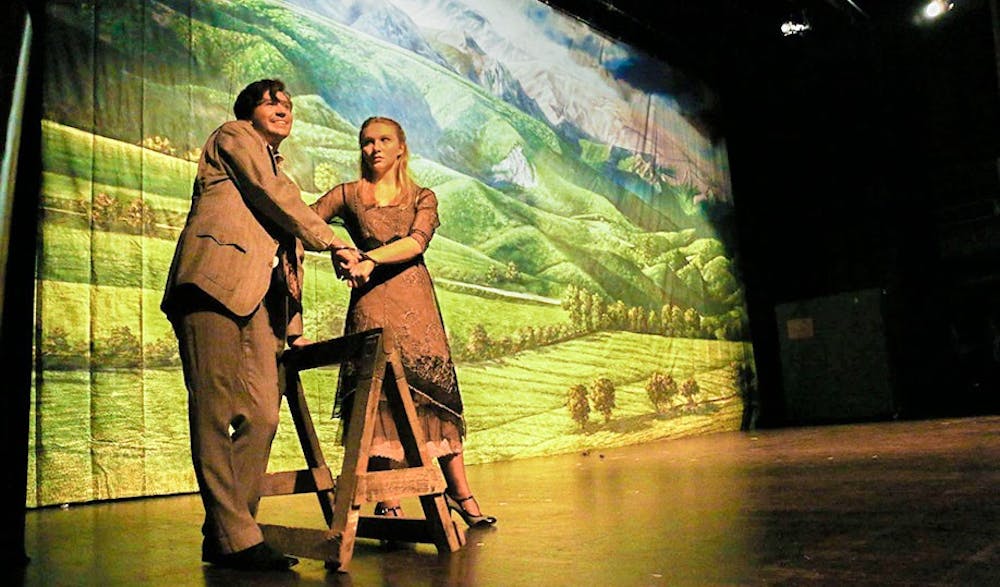If The Three Stooges ran into Bugs Bunny and then collaborated with Deadpool, they would have created something akin to “The 39 Steps.”
It is a play filled with 39 levels of satire that constantly breaks through the fourth wall of the theater world.
The characters in the show knew that they were a part of the performance and recognized the audience, an element that delves past the stumbling humor and becomes an essential part of the plot.
People who cannot see past satire can still understand that the play is about a man searching for answers—in this case the 39 steps, are the blue prints to build a silent plane.
Director Nicholas Ecker of Act V chose “The 39 Steps” for the very fact that it is not a typical “serious” theater production but is “upbeat and funny.” Its small cast of four actors creates a challenge of itself in terms of character changes.
The play demanded the four actors bounce back and forth from more than 20 different characters within instantaneous beats. At one point, three of the actors were riding on a train and switching between seven different characters — a stunt pulled with systematic chaos that transitioned them from passengers, a conductor, the police, investigators, a newspaper deliverer and the two main leads.
In this way the play also required much of its audience to suspend their disbelief. There are self-imposed rules to the execution of “The 39 Steps,” only to be broken. For instance, the audience is asked to believe that the backdrops are real, even in the event that a character later points out that it is fake.
At one point, the main lead, Richard Hannay, played by Tyler Michael Law, tries to make an escape through a window drawn onto the fake wall, but a side character says to him “Not that window, the real window.”
Then, Hannay plays into the fluid transfer of intentional ever-changing rules, literally walking through a large wooden frame that acts as the “real” window.
This mocks conventional stage design of theater itself, and simultaneously represents a deeper element to Hannay’s situation—being framed for murder.
This kind of farce also plays into the actors’ abilities to make mistakes and turn them into intentional elements of the play. A broken table did not seem like an accident to audience members because of the established satircal universe of the play. According to Law, it was not a part of the script.
It naturally played into the actors’ intent — a happy accident that heightened the caliber of the performance.
“When stuff goes wrong in a farce or a comedy, it’s a lot easier to play it off,” Law said.
There may have been multiple mishaps that deviated from the script, but nobody but the actors would have known because of the confidence and skill they used to execute “The 39 Steps.”
Law easily molds into the smug, unpredictable and suave demeanor of Hannay, with his strong performance helping to weave three other characters from one dimension to the next.
“He’s not too different from me. He’s a little bit of a jerk. He’s a little smug. But at the end of the day, [Hannay] is a 37-year-old British guy,” Law said.
However, Law’s acting ability was not alone on stage. Nastassia Foose, who played a sharp, authoritative German spy, a homely farm wife, and ultimately, the femme fatale to Hannay, switched between her roles seamlessly.
Her most vibrant role as Pamela, side-kick and instigator to Hannay, sparked a persistent chemistry between the two characters, which drew out the very characteristic that made them unique.
Finally, the versatility of Clown 1 and Clown 2, played by Eleanor Hargrove and Tristan Seiben, respectively, was essential to moving the plot.
These two actors had the greatest number of roles but never faltered in their abilities to slip into the precise personas of each character.
To anyone who walked away confused by the satire and the changing of characters, there is no denying that the the actors themselves executed “The 39 Steps” with a certain kind of bravado and ease that can only come from talent itself.




The Slate welcomes thoughtful discussion on all of our stories, but please keep comments civil and on-topic. Read our full guidelines here.